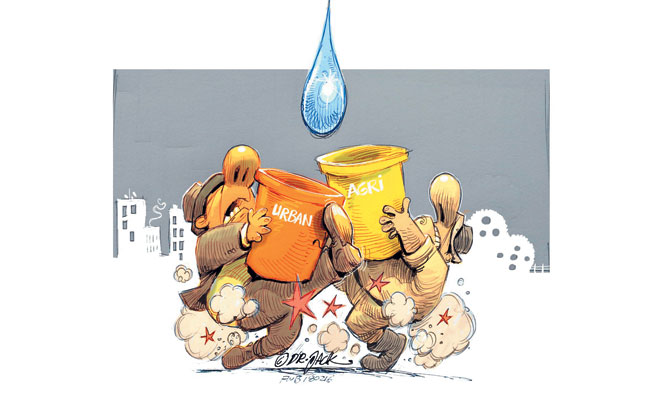
Cities around the world are expanding markedly in size as global urban growth leads to more than two billion additional urban residents by 2030.
Today, approximately 54% of the global population (that is, 3,9 billion people) live in cities, a percentage that is likely to grow to between 60% and 92% by the end of the
21st century, according to scenarios from shared socioeconomic pathways (SSPs).
READ Water availability: crucial to profitable livestock production
The latter are part of a framework developed by climate change researchers to analyse the impact of, and adaptation to, climate change.
Household water use has almost quadrupled over the last 60 years due to increasing population, wealth and access to drinking-water infrastructure, and there has been an even higher increase in general water use in cities.
This trend will continue, with household water use forecast under one scenario to increase by another 80% by 2030.
An earlier study analysing a range of SSP scenarios estimated an increase of between 50% and 250% in global water withdrawals for domestic use by 2050.
This growth in demand comes just as cities are confronted with water-related problems caused by an increase in urban population, rising prosperity and changes in water supply, potentially leading to water shortage and groundwater over-abstraction.
Global hydrological models to assess changes in water cycle
Climate change poses an additional risk to metropolitan areas and is likely to exacerbate the major water challenges of the future.
Global hydrological models are useful tools to simulate changes in the water cycle and quantify the impact of change in both water supply and demand for renewable freshwater availability and sectoral water use.
READ Land: SA’s real watershed moment
Recent studies have estimated that between 3,5 billion and 4,4 billion people are expected to live with water scarcity in 2050 because of climate change and increasing water demand for human activities.
Similarly, water shortage has been identified as a major threat to urban water supply. More than one billion urban residents may face water shortage in the future due to urbanisation and climate change.
Urban-rural comparison
A new study, ‘Water competition between cities and agriculture driven by climate change and urban growth’, has assessed urban water provision amid climate change impacts and socioeconomic changes by 2050.
The study also provides estimates of the urban surface-water deficit, highlighting the competition between urban water provision, agricultural water demand and environmental flow requirements.
READ Realising a dream with urban aquaponic farming
Finally, it addresses the implications for groundwater resource uses. The research focuses on 482 cities containing 736 million people.
The study quantifies the urban surface-water deficit as well as additional withdrawals from groundwater resources (urban groundwater footprint) in the future by testing two scenarios.
In the first, urban dwellers have the highest priority to be supplied with water (first priority); in the second, urban dwellers have the lowest priority after other water users, such as industry and agriculture.
The finding was that if cities have first priority over other sectors, 16,1% of the cities studied with surface-water withdrawal points experienced at least one month with a surface-water deficit within the baseline period between 1971 and 2000 (hereafter referred to as the baseline).
A surface-water deficit means that the available amount of surface water is less than the demand, and that cities must therefore depend on water storage to make it through such periods.
Considering the effects of global warming and urbanisation, the number of cities affected by surface-water deficit is likely to increase to 27,6% in 2050.
By contrast, 38,9% of cities would be vulnerable to an urban surface-water deficit if cities had the lowest priority.
Urban-agricultural conflict
In 41% of all river basins, the needs of agricultural water users will clash with those of cities, as there is not enough water to supply both urban and agricultural needs.
South Asia is a hotspot region where competition between urban and agricultural demand is generally highest.
Globally, under the urban-first priority scenario, about 14 000km2 of irrigated area will be at risk of crop-water deficit in transfer of water, showing that urban surface-water withdrawals decrease water security for people who live far from the city centre.
Therefore, the number of people in the studied cities and their source watersheds affected by urban surface-water deficits is much higher (up to 1,4 billion if environmental factors are considered).
Reducing urban water deficit
Altogether, 40% of the cities (409 million people) are vulnerable to urban surface-water deficits under the last-priority scenario because of competition with water abstractions for irrigation.
Urban water demand could be met in these basins by improving water-use efficiency of the agricultural sector as a soft-path measure to reduce irrigation-water withdrawals.
Efficiency improvements can result from switching from less efficient flood irrigation to more efficient sprinkler or drip irrigation, reducing leakages in water infrastructure to lands, changes in plant varieties, and better information on when and where to irrigate.
A moderate increase of 10% in irrigation water-use efficiency (0,3%/year over a 50-year period), could reduce the urban surface-water deficit by about 2,62 billion cubic metres and therefore help 78% of the vulnerable cities and their 236 million urbanites to overcome water deficits in the future. – Staff reporter
The views expressed in our weekly opinion piece do not necessarily reflect those of Farmer’s Weekly.
This is a summary of the article ‘Water competition between cities and agriculture driven by climate change and urban growth’ published in the online journal Nature Sustainability in January 2018. It was written by Martina Flörke, Christof Schneider and Robert I McDonald.










